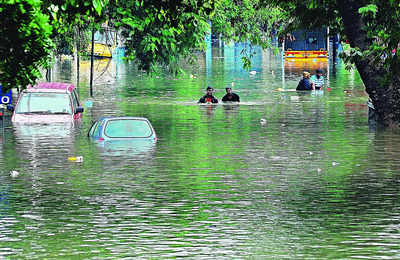[ad_1]

NEW DELHI: Extreme weather events, including droughts and heavy rains driven by climate change, could increase the risk of nitrates from fertilisers in soil percolating down, thereby contaminating groundwater rapidly, according to a recent study. Previous studies have shown that about 40 per cent of nitrogen fertilisers used for vegetables is not absorbed by the plants, but remains in the soil. During droughts, crops do not use nitrogen efficiently, leading to excess nitrogen in the soil, researchers explained.
This study, published in the journal Water Resources Research, found that sudden bursts of water from heavy rains following a drought caused nitrates — a component of nitrogen fertiliser — to seep 33 feet, or 10 metres, in as little as 10 days.
“The conventional wisdom was that it could take several weeks to years for nitrates to move from the crop root zones to reach groundwater,” corresponding author Isaya Kisekka, a professor at the University of California – Davis, US, said.
“We found these extreme events, such as California’s atmospheric rivers, are going to move nitrate more quickly,” Kisekka said.
Groundwater contamination caused by nitrates due to intensive agriculture and the excess use of fertilisers is a significant issue across several European Union countries, India, the North China Plain, and New Zealand, often exceeding the maximum contaminant level, the authors said.
An atmospheric river is a long, narrow corridor in the atmosphere — resembling a river in the sky — that carries moisture away from the tropics to higher latitudes. Upon landfall, an atmospheric river can cause extreme rainfall, potentially resulting in floods.
In India, atmospheric rivers are predominantly known to occur in the monsoon season during summer months (June to September).
An April 2023 study, published in the journal Communications Earth and Environment, found that a total of 574 atmospheric rivers occurred in the monsoon seasons from 1951-2020, with the weather event becoming more common over time. Further, in the past two decades, nearly 80 per cent of the most severe atmospheric rivers caused floods, it found.
In this study, the researchers measured how much nitrate was seeping down through the soil in a tomato and cucumber crop near Esparto in the US state of California.
The study was conducted from 2021 until 2023 when California was experiencing periods of drought followed by atmospheric rivers, the team said. They measured nitrate during both the growing seasons and the rainy seasons.
“These extreme events that come with climate change are going to make the risk of these chemicals ending up in our drinking water much more severe,” Kisekka said.
The authors said that using conservation practices that limit leftover nitrates in the crop’s root zone after harvest could help farmers reduce groundwater contamination.
Affordable tools for monitoring nitrates in soil real-time can help farmers manage the use of fertilisers efficiently, Kisekka said.
[ad_2]
Source link


